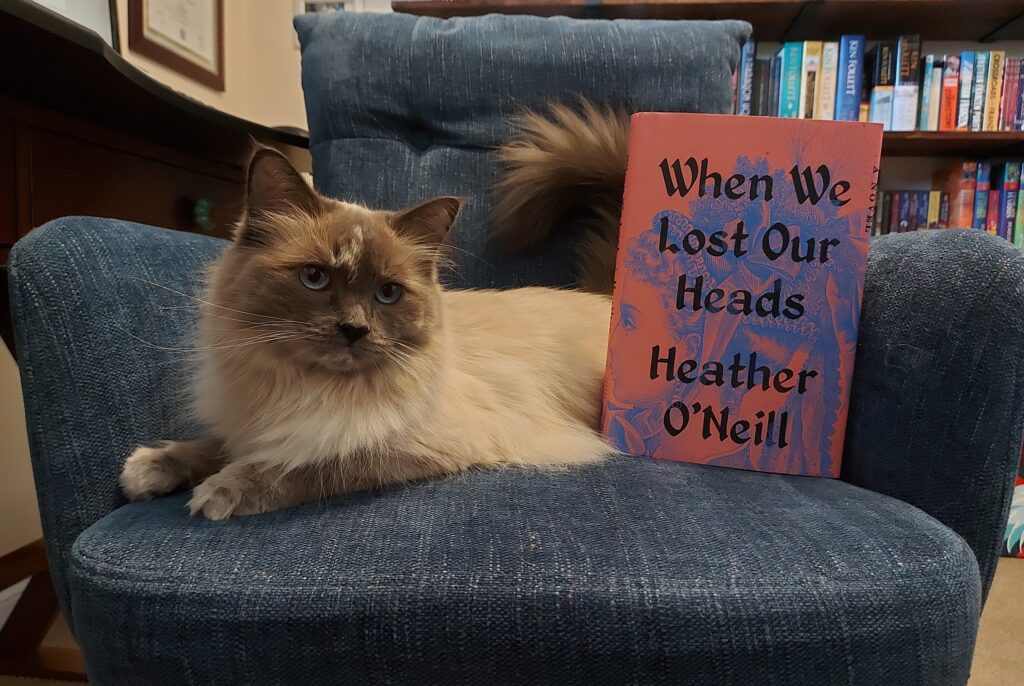When We Lost Our Heads by Heather O’Neill

I was instantly drawn to the cover of Heather O’Neill’s When We Lost Our Heads. But then I read the synopsis and decided to give it a pass because the main characters sounded insufferable. I ended up buying it because of the glowing reviews, and because I needed one more book to get free shipping for my Book Outlet order. I reluctantly started reading it when nothing else in my TBR pile called out to me. I was right about the main characters being insufferable, but it turns out there is much more to When We Lost Our Heads then the loathsome relationship between the main characters, and I ended up being wholly engrossed in this novel as I read it.
When We Lost Our Heads is set in Montreal in the 19th century and is about two girls from the upper class of society: Marie Antoine, the daughter of the richest man in Montreal, and Sadie Arnett, the daughter of a not-so-wealthy aspiring politician. Marie is a beautiful blonde but incredibly spoilt child; she may be intelligent, but she is too lazy to learn anything. Sadie, on the other hand, is dark and clever and scheming; she hates her family, and her family hates her. Marie and Sadie have an intense love-hate friendship that ends when they decide to have a duel with real pistols; instead of shooting each other, though, they accidentally shoot and kill a maid from Marie’s household.
Marie’s father and Sadie’s family conspire for Sadie to take the fall for the maid’s death, and Sadie is exiled to boarding school in England, where she discovers pornography and self-pleasure. Marie spends years feeling lost without Sadie, but when her father unexpectedly dies and she inherits his sugar factory, Marie throws herself into the family business and turns out to be a shrewd businesswoman. She uses her power and influence to have Sadie brought back to Montreal, but Sadie blames Marie for her exile and does not want anything to do with her. Instead, Sadie moves into a brothel where she writes and publishes a pornographic novel, which is about her obsessive love for Marie.
You would think these two 19th century Girlbosses, one running a successful business empire and the other publishing a successful novel, would be admirable characters, but the problem with Marie and Sadie is their complete lack of empathy. They literally do not care about anyone but themselves. Thankfully, When We Lost Our Heads is the kind of novel where the main characters get exactly what they deserve in the end.
What I found fascinating about When We Lost Our Heads is how Sadie’s novel inspires a female revolution in the lower class of society, where women discover their own sexuality and as a result begin to demand the right to their own bodily autonomy. Female workers go on strike, demanding safe working conditions for themselves and their children, and better wages. Gangs of women roam the streets at night attacking men who have brutalized women, and men learn to hurry home at night lest they become one of their victims. And eventually, the women’s ire turns towards Marie and Sadie, the two women who have used them for their own gain. But the upper class is indifferent to their suffering and dismiss their revolution as a product of mania.
O’Neill delves into the world of the poor factory worker, contrasting it with the comfortable lives of the wealthy who get rich off their labour, but When We Lost Our Heads just goes to show that revolutions are cyclical. Here we are in the 21st century, and society is going back in time as those in power strip the rest of us of the rights that previous generations fought so hard for. It is just a matter of time before we lose our heads again.